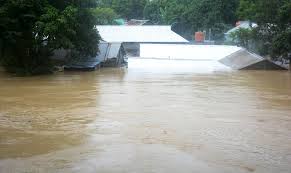
Flood conditions in Tripura have slightly improved as Chief Minister Manik Saha conducted an aerial survey of the affected areas on Friday. The devastating floods, which have impacted the state for the first time in over 30 years, continue to affect large areas despite a reduction in rainfall intensity.
According to Disaster Management officials, most of Tripura’s rivers are overflowing, with the state’s primary river, Gomati, still flowing at 22.30 meters—well above the extreme danger level of 22 meters. The floods have left 65,500 people sheltered in 450 relief camps across all eight districts of the state. The deluge, which began on Monday, has affected approximately 1.7 million people.
Tragically, the floods have resulted in at least 21 deaths due to landslides and drownings, with two individuals still reported missing. As a response, Chief Minister Saha has been actively involved in overseeing relief operations, visiting several relief camps and surveying the hardest-hit regions, including Udaipur, Amarpur, and Karbook.
Government Response
Union Home Minister Amit Shah has announced that the central government, led by Prime Minister Narendra Modi, has approved an advance release of ₹40 crore from the State Disaster Response Fund (SDRF) to aid in relief efforts. Shah emphasized the Centre’s commitment to supporting Tripura through these challenging times and highlighted the deployment of 11 National Disaster Response Force (NDRF) teams, three Army columns, and four Air Force helicopters to assist in rescue and relief operations.
Chief Minister Saha expressed gratitude for the support from the central government and reiterated the state’s commitment to addressing the disaster’s impacts. The India Meteorological Department (IMD) has forecasted the possibility of heavy rainfall over the next five days due to a low-pressure area over northern West Bengal and northeast Jharkhand, and another cyclonic circulation over the north Bay of Bengal.
Ongoing Challenges
The flood’s aftermath has led to significant infrastructure damage, with over 1,055 houses either fully or partially damaged and hundreds of trees uprooted, obstructing key highways. Landslides have occurred in 2,032 locations, though most have been cleared by Thursday evening. Additionally, heavy rains have damaged railway tracks in Gomati and South Tripura districts, leading to the cancellation of several local trains by the Northeast Frontier Railways (NFR).
Preliminary estimates suggest that around 5,000 hectares of vegetable farms and 1.2 lakh hectares of other crop lands remain submerged, highlighting the extensive agricultural damage caused by the floods.
Sources By Agencies




